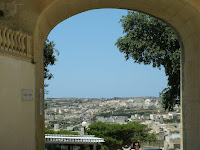We will arrive in Brest, France on Friday morning. We will be docked at
the French Naval base there. For those of you who know little about our
next port, here is a condensation of the fact sheet that I have written
for the cadets and crew.
France's Brittany region is a distinct area on the country's northwest
coast. It is a vast plateau of rocky, sandy soil and scrub trees. It has
a rugged coastline with many bays, inlets, estuaries, capes and offshore
islands dotted by numerous lighthouses. The area is populated by the
Bretons, a Celtic people related more to the Irish and Welsh than the
Gallic people of rest of France. While French is the official language,
Breton, similar to Gaelic, is also spoken. Most names in the region are
in Breton. Brittany was contested for centuries by the French and
English and as such, there are many medieval castles and cathedrals
located throughout the district. There are several cities in the region
most notable being Rennes and Nantes, and many small, picturesque towns.
Brittany is mainly agricultural, known especially for its apples used to
make alcoholic cider. Fishing is also an important industry in a region
that has such a long coastline along the Atlantic in the southwest and the
English Channel in the north.
Brest is best known as the port of the French Navy's Atlantic fleet.
Sited in a natural harbor on the Atlantic at the mouth of the Penfeld
River, the city has a rich military history. Seized by the Germans in
WWII and made the base of their submarine activities, Brest suffered
severe damage by Allied bombing during the war. As such, most of the
pre-war historic buildings were destroyed. Brest was re-built with
modern, rather sterile, architecture giving it the reputation of "one of
France's ugliest cities."
It is not without some charm. Its waterfront does have a few remaining
old buildings and museums as well as beautiful views across the bay of
the Plougastel Peninsula. One of the City's oldest monuments is the Tour
Tanguy, a 14th century lookout tower. Crossing the Penfeld River by the
bridge next to the tower (the longest lift-bridge in Europe) takes one to
Brest's medieval castle which houses the Musèe de la Marine, the naval
museum. Nearby is the Musèe Municipal, an art museum displaying French,
Flemish and Italian treasures from the 17th to the 20th centuries.
Europe's largest aquarium is located in Brest at the futuristic
Ocèanopolis center.
About 65 miles south of the city is the medieval village of Quimper. The
village hosts the 9 day Celtic extravaganza, the Festival de Cornouaille,
in mid-July. The town is also home to the beautiful, gothic Cathedrale
St-Corentin, the 2nd largest cathedral in France. Next to the cathedral
is the Musee des Beaux-Arts housing more than 400 works of art from
artists such as Rubens, Corot and Picasso. Quimber is known for its
distinctive earthenware pottery.
Further south in what is considered to be the prettiest area of Brittany
is the town of Pont-Aven. It was made famous by the artist Paul Gauguin
who established an artist's colony there. Still further south lays the
village of Carnac, known for its beaches and the ancient stone monuments.
The 6,500 year old monuments are contemporary to Stonehenge in England and
are equally impressive.
The city of Nantes is at the southernmost corner of Brittany. It is the
cultural center of the region. There are many historic building, museums
and a cathedral here.
Northern Brittany, on the Channel coast, is full of many quaint fishing
villages. To the east is the Channel port of St. Malo. Here ferries
embark for England on a regular basis. Just east of St. Malo, in the south
west corner of Normandy is the famed Mt. St. Michel. This impressive
fortress/monastery sits on a mount that is attached to the mainland at low
tide and becomes an island at high tide. The tides here are among the
most extreme in the world, rising some 45' with the tide rushing in with a
tidal bore.
Dinan, south of St. Malo is one of the best preserved medieval towns in
France. There is a medieval festival held there the 3rd week of July that
includes jousting, a market, parades and music.
In the easternmost section of Brittany is Rennes, the capital of the
region. It is a mixture of medieval and 18th century architecture due
to a fire which destroyed half the City in 1720. Sites here are the
Parlement de Bretagne, the Musèe de Bretagne and the Musèe de Beaux Arts.
It looks as if we will have a tour of Normandy, arranged by the College,
on Saturday. This will be a very long tour, about 18 hours, and will take
us to all of the historic landmarks in the neighboring region. Everyone
is looking foreword to this. Several other shorter tours of Brittany are
also being offered.












